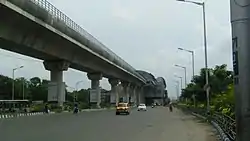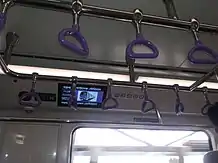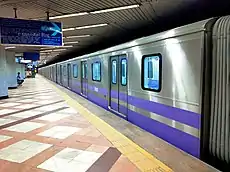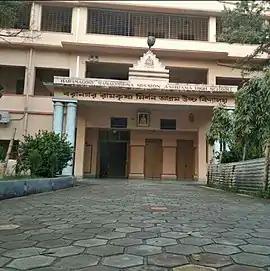Kolkata Metro
The Kolkata Metro is a rapid transit (MRT) system serving the city of Kolkata in West Bengal, India. As of July 2020, it has two operational lines, a 27.22 km (16.91 mi) line from Noapara to Kavi Subhash and a 7.205 km (4.477 mi)[3] line from Salt Lake Sector V to Phoolbagan, for a total of 34.425 km (21.391 mi). Four other lines are in various phases of construction. The system has a mix of underground, at-grade and elevated stations using both broad-gauge and standard-gauge tracks. Trains operate between 05:45 and 21:55 IST and the fares range from ₹5 to ₹30 (US$0.07 to US$0.40).
 | |||
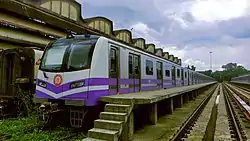 CRRC Dalian rake at Noapara depot | |||
| Overview | |||
|---|---|---|---|
| Owner | |||
| Area served | Kolkata, North 24 Parganas and South 24 Parganas | ||
| Locale | Kolkata, West Bengal, India | ||
| Transit type | Rapid Transit | ||
| Number of lines |
| ||
| Line number | Line 1 Line 2 | ||
| Number of stations | 31 (Operational) 37 (Under Construction) 26 (Planned) | ||
| Daily ridership | Over 700,000 | ||
| Chief executive | |||
| Headquarters |
| ||
| Website | |||
| Operation | |||
| Began operation | 24 October 1984 | ||
| Operator(s) | Metro Railway, Kolkata | ||
| Host railroads | Indian Railways | ||
| Number of vehicles | 41 | ||
| Train length | 6 and 8 Coaches (Initially 4) | ||
| Headway | 5, 6, 8, 10, 15, 20 Minutes | ||
| Technical | |||
| System length | 34.425 km (21.391 mi) | ||
| Track gauge | 1,676 mm (5 ft 6 in) (Broad gauge) for Line 1 1,435 mm (4 ft 8 1⁄2 in) (Standard gauge) for Line 2 | ||
| Electrification | 750 V DC Third Rail | ||
| Average speed | 55–60 km/h (34.18–37.28 mph) | ||
| Top speed | 80 km/h (50 mph) | ||
| |||
| Part of a series of articles on the |
| Kolkata Metro |
|---|
|
|
The Kolkata Metro is the first planned and operational rapid transit system in India. It was initially planned in the 1920s, but construction started in 1970s. The first underground stretch, from Bhawanipore (now Netaji Bhawan) to Esplanade, opened in 1984. Line 2, or the East–West Corridor, opened in 2020. It is the fifth-longest operational metro network in India after the Delhi Metro, Hyderabad Metro, Bengaluru Metro and Chennai Metro.
Metro Railway, Kolkata and Kolkata Metro Rail Corporation are the owners and operator of the system. On 29 December 2010, Metro Railway, Kolkata, became the 17th zone of the Indian Railways, completely owned and funded by the Ministry of Railways. It is the only metro in the country to be controlled by Indian Railways. There are around 300 daily train trips carrying more than 700,000 passengers.
History
Early attempts
In the September 1919 session of the Imperial Legislative Council at Shimla, a committee was set up by W. E. Crum that recommended a metro line for Kolkata.[4] This line was supposed to connect Bagmari in the east to Benaras Road, Salkia, in Howrah in the west via a tunnel beneath Hooghly River. The estimated construction costs were £3,526,154, about ₹4.28 crore (US$600,000) based on current exchange rates, and the proposed deadline was 1925–1926. The proposed line was 10.4 km (6.5 mi) long, about 4 km (2.5 mi) shorter than the current East-West Corridor, which would connect East Bengal Railway in Bagmari and East Indian Railway in Benaras Road. The tickets were priced at 3 annas (Rs. 0.1875) for the full trip. Crum also mentioned a north–south corridor back then. An east–west metro railway connection, named the "East–West Tube Railway", was proposed for Kolkata in 1921 by Harley Dalrymple-Hay. All the reports can be found in his 1921 book Calcutta Tube Railways. However, in 1923, the proposal was not undertaken due to a lack of funds.[5][4][6]
Planning
The then Chief Minister of West Bengal, Bidhan Chandra Roy, reconceived the idea of an underground railway for Kolkata in the early 1949–1950. A survey was done by a team of French experts, but nothing concrete came of this. Efforts to solve problem traffic by augmenting the existing fleet of public transport vehicles hardly helped, since roads accounted for only 4.2 percent of the surface area in Kolkata, compared with 25 percent in Delhi and 30 percent in other cities. To find alternative solutions, the Metropolitan Transport Project (MTP) was set up in 1969. The MTP, with the help of Soviet specialists, Lenmetroproekt and East German engineers, prepared a master plan to provide five rapid-transit (metro) lines for the city of Kolkata, totaling a length of 97.5 km (60.6 mi), in 1971.[7] However, only three were selected for construction. These were:[8][9]
- Dum Dum – Tollygunge (Line 1. Presently operates from Noapara to New Garia)
- Bidhannagar – Ramrajatala (Line 2. Presently truncated till Howrah Maidan)
- Dakshineswar – Thakurpukur (Divided into Line 1; Noapara to Dakshineswar and Line 3; Joka to Esplanade)
The highest priority was given to the busy north–south corridor between Dum Dum and Tollygunge over a length of 16.45 km (10.22 mi); work on this project was approved on 1 June 1972. A tentative deadline was fixed to complete all the corridors by 1991.[10]
Construction

Since it was India's first metro[11] and was constructed as a completely indigenous process, a traditional cut-and-cover method and driven shield tunneling was chosen and the Kolkata Metro was more of a trial-and-error affair, in contrast to the Delhi Metro, which saw the involvement of multiple international consultants. As a result, it took nearly 23 years to completely construct the 17 km (11 mi) underground railway.[9][12]
The foundation stone of the project was laid by Indira Gandhi, the Prime Minister of India, on 29 December 1972, and construction work started in 1973–74. Initially, cut and cover along with slurry wall construction to handle soft ground, was recommended by the Soviet Union Consultants. Later, in 1977, it was decided to adopt both shield tunneling and cut and cover methods for construction under populated areas, sewer lines, water mains, electrical cables, telephone cables, tram lines, canals etc. The technology was provided by M/s NIKEX Hungarian Co., Budapest.[13] In the early days, the project was led by the Union Railway Minister from West Bengal, A. B. A. Ghani Khan Choudhury, often against the prevailing socio-political stance of his contemporaries in the West Bengal government. From the start of construction, the project had to contend with several problems including insufficient funds (until 1977–1978), a shifting of underground utilities, court injunctions, and an irregular supply of vital materials.[9][14] In 1977, an injunction for the allocation of new funding was passed by the newly elected Jyoti Basu government.[15]
Despite all the hurdles, services began on 24 October 1984, with the commissioning of a partial commercial service covering a distance of 3.40 km (2.11 mi) with five stations served between Esplanade and Bhowanipur (currently Netaji Bhavan).[7] The first metro was driven by Tapan Kumar Nath and Sanjoy Sil. The service was quickly followed by commuter services on another 2.15 km (1.34 mi) stretch in the north between Dum Dum and Belgachhia on 12 November 1984. The commuter service was extended to Tollygunge on 29 April 1986, covering a further distance of 4.24 km (2.63 mi), making the service available over a distance of 9.79 km (6.08 mi) and covering 11 stations. However, the services on the north section were suspended starting 26 October 1992, as this small, isolated section was little used.[14] The Line 1 was almost entirely built by cut and cover method, while a small 1.09 km stretch between Belgachia and Shyambazar was built using shield tunneling with compressed air and air locks, since the alignment crossed a railway yard (now Kolkata railway station) and Circular Canal.[13][16][17]
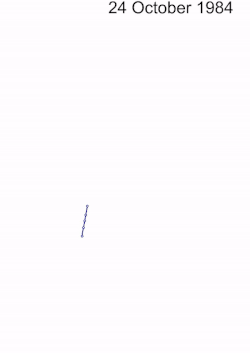
After more than eight years, the 1.62 km (1.01 mi) Belgachhia–Shyambazaar section, along with the Dum Dum–Belgachhia stretch, was opened on 13 August 1994. Another 0.71 km (0.44 mi) stretch from Esplanade to Chandni Chowk was commissioned shortly afterwards, on 2 October 1994. The Shyambazaar-Shobhabazar–Girish Park (1.93 km [1.20 mi]) and Chandni Chowk–Central (0.60 km [0.37 mi]) sections were opened on 19 February 1995. Services on the entire stretch of the Metro were introduced from 27 September 1995 by bridging the 1.80 km (1.12 mi) gap with Mahatma Gandhi Road metro station in the middle.[18]
In 1999–2000, the extension of Line 1 along an elevated corridor from Tollygunge to New Garia, with six stations, was sanctioned at a cost of ₹907 crore (equivalent to ₹31 billion or US$440 million in 2019).[19] The section was constructed and opened in two phases, Mahanayak Uttam Kumar to Kavi Nazrul in 2009 and Kavi Nazrul to Kavi Subhash in 2010. The latest extension opened was the 2.59 km (1.61 mi) stretch from Dum Dum to Noapara on 10 July 2013.[9][20][14]
East–West metro
The master-plan of the metro corridor was made in 1971 along with the North–South Corridor, connecting the office district of Bidhannagar with the twin city and transportation hub Howrah via another transport hub of the city, Sealdah, and the central business district Esplanade by an underwater metro line. It is a ₹4,874.6 crore (equivalent to ₹110 billion or US$1.5 billion in 2019) project, sanctioned in 2008 by Prime Minister Manmohan Singh. The foundation stone was laid on 22 February 2009 and construction started in March 2009.[21] The autonomous Kolkata Metro Rail Corporation (KMRC) was formed to implement the project. The Government of India (Ministry of Urban Development) and Government of West Bengal each had a half-share in it. Later, the Government of West Bengal pulled out from it, and the shares were transferred to the Ministry of Railways.[22]
Route realignment
Chief Minister Mamata Banerjee proposed the politically controversial realignment of the East-West Corridor from Central to Esplanade in 2012, stating that the original plan would affect 250 shop-owners and tenants in the Lalbazar and Bowbazar area. The residents and traders of those areas started protests. KMRC and JICA requested the Government of West Bengal to stick to the original plan to avoid impacting the entire project. This was the first time in the country that a metro corridor alignment was being changed after preparation of DPR and sanction of the project. Despite opposition from the official agencies, the Government of West Bengal forcefully approved the route realignment in 2013. This changed the location of Mahakaran metro station and increased the length of the corridor by 2 km (1.2 mi). Later, KMRC said that the realignment would increase ridership and revenue by at least 30 percent.[24][25][26]
The realignment led to many other issues and delays. Some of the biggest issues were the H-piles under Esplanade metro station and the Bowbazar mishap. As per the 1971 master plan, the East-West Corridor was supposed to pass under Central metro station, so the square foundational beams in Esplanade were not removed. Since the Tunnel Boring Machines (TBMs) cannot cut through steel, another small tunnel was dug using New Austrian tunnelling method (NATM) and the H-piles were cut manually. This extended the tunneling process by one and a half months.[27][28][29] In September 2019, during the construction of the eastbound tunnel (from Esplanade to Sealdah), a TBM hit an aquifer under Bowbazar, causing a major collapse in the area, delaying work in that section for several months. Around 80 houses were damaged and many buildings were declared unsafe, affecting more than 600 people. Later subsidence in the was checked using grouting.[30][31][32]
Expansion planning
By 2011–2012, the Railway Ministry had announced plans for the construction of five new metro lines and an extension of the existing north–south corridor. These were:[33]
- Salt Lake – Howrah Maidan (Line 2 or East–West Metro Corridor)
- Joka – B.B.D. Bagh (Line 3. Later truncated till Esplanade)
- Noapara–Barasat (Line 4, via airport)
- Baranagar–Barrackpore (Line 5)
- New Garia – Dum Dum Airport (Line 6)
- Extension of Line 1 from Dum Dum to Dakshineswar via Noapara
Major modifications
A new four-platform interchange station was constructed at Noapara. This will act as an interchange station between Line 1 and Line 4. For the time being, only two platforms are in use, but once Line 4 is running, all four platforms will be operational.[20][34] The existing Esplanade metro station is being upgraded and a subway is being constructed to the new metro station to provide an interchange among Line 1, Line 2 and Line 3.[35][36] In 2009–2010, Line 1 underwent upgrades of services and amenities and many stations were renamed after famous personalities by then Minister of Railways Mamata Banerjee.[37]
Network
Operational
| Line | First run | Last extension | Stations | Length (km) | Orientation | Operating terminals | Rolling stock | Track gauge (mm) | Power | Frequency (min) | ||
|---|---|---|---|---|---|---|---|---|---|---|---|---|
| Line 1 | 24 October 1984[38] | 10 July 2013 | 24 | 31.37 | North–South | Dakshineswar | DumDum | Kavi Subhash | ICF | 1,676 mm (5 ft 6 in) | 750 V DC | 5,7,10,15 |
| Line 2 | 13 February 2020[39] | 4 October 2020 | 7 | 7.29 | East–West | Salt Lake Sector-V | Phoolbagan | BEML | 1,435 mm (4 ft 8 1⁄2 in)[40] | 750 V DC | 30 | |
| Total | 31 | 38.66 | ||||||||||
Under construction/planned
| Line name | Expected first run | Stations | Length (km) |
Orientation | Terminals | Rolling stock | Track gauge | Power | Executing agency | Notes | |
|---|---|---|---|---|---|---|---|---|---|---|---|
| Line 3 | 2021 (Joka–Majerhat)[41] | 14 | 17.22[42] | North–South | Diamond Park | Esplanade | ICF | 1,676 mm (5 ft 6 in) | 750 V DC using third rail | Rail Vikas Nigam Limited | Also called Joka metro |
| Line 4 | 2021 (Noapara–Biman Bandar)[41] | 10 | 16.88[42] | North–South & East–West | Noapara | Barasat | ICF | Metro Railway, Kolkata | Also called Barasat metro | ||
| Line 5 | 2025 (Baranagar-Barrackpore)[41] | 11 | 12.45[42] | North–South | Baranagar | Barrackpore | TBD | Rail Vikas Nigam Limited | Also called Barrackpore metro | ||
| Line 6 | 2021 (Kavi Subhash – Hemanta Mukherjee)[41] | 24 | 30.25[42] | North–South | Kavi Subhash | Biman Bandar | CRRC Dalian | Rail Vikas Nigam Limited[43] | Also called Airport metro | ||
| Total | 94 (102 If interchanges counted multiple times) | 124.77 | |||||||||
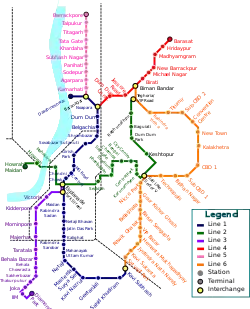
| Kolkata Metro | ||||||||||||||||||||||||||||||||||||||||||||||||||||||||||||||||||||||||||||||||||||||||||||||||||||||||||||||||||||||||||||||||||||||||||||||||||||||||||||||||||||||||||||||||||||||||||||||||||||||||||||||||||||||||||||||||||||||||||||||||||||||||||||||||||||||||||||||||||||||||||||||||||||||||||||||||||||||||||||||||||||||||||||||||||||||||||||||||||||||||||||||||||||||||||||||||||||||||||||||||||||||||||||||||||||||||||||||||||||||||||||||||||||||||||||||||||||||||||||||||||||||||||||||||||||||||||||||||||||||||||||||||||||||||||||||||||||||||||||||||||||||||||||||||||||||||||||||||||||||||||||||||||||||||||||||||||||||||||||||||||||||||||||||||||||||||||||||
|---|---|---|---|---|---|---|---|---|---|---|---|---|---|---|---|---|---|---|---|---|---|---|---|---|---|---|---|---|---|---|---|---|---|---|---|---|---|---|---|---|---|---|---|---|---|---|---|---|---|---|---|---|---|---|---|---|---|---|---|---|---|---|---|---|---|---|---|---|---|---|---|---|---|---|---|---|---|---|---|---|---|---|---|---|---|---|---|---|---|---|---|---|---|---|---|---|---|---|---|---|---|---|---|---|---|---|---|---|---|---|---|---|---|---|---|---|---|---|---|---|---|---|---|---|---|---|---|---|---|---|---|---|---|---|---|---|---|---|---|---|---|---|---|---|---|---|---|---|---|---|---|---|---|---|---|---|---|---|---|---|---|---|---|---|---|---|---|---|---|---|---|---|---|---|---|---|---|---|---|---|---|---|---|---|---|---|---|---|---|---|---|---|---|---|---|---|---|---|---|---|---|---|---|---|---|---|---|---|---|---|---|---|---|---|---|---|---|---|---|---|---|---|---|---|---|---|---|---|---|---|---|---|---|---|---|---|---|---|---|---|---|---|---|---|---|---|---|---|---|---|---|---|---|---|---|---|---|---|---|---|---|---|---|---|---|---|---|---|---|---|---|---|---|---|---|---|---|---|---|---|---|---|---|---|---|---|---|---|---|---|---|---|---|---|---|---|---|---|---|---|---|---|---|---|---|---|---|---|---|---|---|---|---|---|---|---|---|---|---|---|---|---|---|---|---|---|---|---|---|---|---|---|---|---|---|---|---|---|---|---|---|---|---|---|---|---|---|---|---|---|---|---|---|---|---|---|---|---|---|---|---|---|---|---|---|---|---|---|---|---|---|---|---|---|---|---|---|---|---|---|---|---|---|---|---|---|---|---|---|---|---|---|---|---|---|---|---|---|---|---|---|---|---|---|---|---|---|---|---|---|---|---|---|---|---|---|---|---|---|---|---|---|---|---|---|---|---|---|---|---|---|---|---|---|---|---|---|---|---|---|---|---|---|---|---|---|---|---|---|---|---|---|---|---|---|---|---|---|---|---|---|---|---|---|---|---|---|---|---|---|---|---|---|---|---|---|---|---|---|---|---|---|---|---|---|---|---|---|---|---|---|---|---|---|---|---|---|---|---|---|---|---|---|---|---|---|---|---|---|---|---|---|---|---|---|---|---|---|---|---|---|---|---|---|---|---|---|---|---|---|---|---|---|---|---|---|---|---|---|---|---|---|---|---|---|---|---|---|---|---|---|---|---|---|---|---|---|---|---|---|---|---|---|---|---|---|---|---|---|---|---|---|---|---|---|---|---|---|---|---|---|---|---|---|---|---|---|---|---|---|---|---|---|---|---|---|---|---|---|---|---|---|---|---|---|---|---|---|---|---|---|---|---|---|---|---|---|---|---|---|---|---|---|---|---|---|---|---|---|---|---|---|---|---|---|---|---|---|---|---|---|---|---|---|---|---|---|---|---|---|---|---|---|---|---|---|---|---|---|---|---|---|---|---|---|---|---|---|---|---|
| ||||||||||||||||||||||||||||||||||||||||||||||||||||||||||||||||||||||||||||||||||||||||||||||||||||||||||||||||||||||||||||||||||||||||||||||||||||||||||||||||||||||||||||||||||||||||||||||||||||||||||||||||||||||||||||||||||||||||||||||||||||||||||||||||||||||||||||||||||||||||||||||||||||||||||||||||||||||||||||||||||||||||||||||||||||||||||||||||||||||||||||||||||||||||||||||||||||||||||||||||||||||||||||||||||||||||||||||||||||||||||||||||||||||||||||||||||||||||||||||||||||||||||||||||||||||||||||||||||||||||||||||||||||||||||||||||||||||||||||||||||||||||||||||||||||||||||||||||||||||||||||||||||||||||||||||||||||||||||||||||||||||||||||||||||||||||||||||
|
Line 1 Dakshinerwar to Kavi Subhash | ||||||||||||||||||||||||||||||||||||||||||||||||||||||||||||||||||||||||||||||||||||||||||||||||||||||||||||||||||||||||||||||||||||||||||||||||||||||||||||||||||||||||||||||||||||||||||||||||||||||||||||||||||||||||||||||||||||||||||||||||||||||||||||||||||||||||||||||||||||||||||||||||||||||||||||||||||||||||||||||||||||||||||||||||||||||||||||||||||||||||||||||||||||||||||||||||||||||||||||||||||||||||||||||||||||||||||||||||||||||||||||||||||||||||||||||||||||||||||||||||||||||||||||||||||||||||||||||||||||||||||||||||||||||||||||||||||||||||||||||||||||||||||||||||||||||||||||||||||||||||||||||||||||||||||||||||||||||||||||||||||||||||||||||||||||||||||||||
Lines
North–South metro (Line 1)
Line 1, or the North–South metro corridor, has a total length of 27 kilometres (17 mi) serving 24 stations, of which 15 are underground, 9 are elevated and 2 at-grade. It uses the five foot six inch (1.67 m) broad gauge tracks. It was the first underground railway to be built in India, with the first trains running in October 1984 and the full stretch that had been initially planned completed and operational by February 1995. The southward extension of Line 1 to an elevated corridor from Tollygunge to New Garia was constructed and opened in two phases, Mahanayak Uttam Kumar to Kavi Nazrul in 2009 and Kavi Nazrul to Kavi Subhash in 2010. The latest extension constructed was the 2.59 km (1.61 mi) elevated corridor from Dum Dum to Noapara in 2013.[14][44][45]
A northward extension from Dum Dum to Dakshineswar (6.20 km [3.85 mi]) was sanctioned and included in the 2010–2011 budget at a cost of ₹227.53 crore (equivalent to ₹411 crore or US$58 million in 2019). The commercial operations for Dum Dum to Noapara (2.09 km [1.30 mi]) was commissioned in March 2013, and construction from Noapara to Dakshineswar with an interchange with Line 5 at Baranagar (2.38 km [1.48 mi]) is being executed by RVNL. This section is expected to open in February 2021[46] with a projected ridership of 55,000 by 2030.[47]
An upgrade of the existing signalling system from Indian Railways Signalling to Communication Based Train Control was proposed by Metro Railway, Kolkata, at a cost of ₹467 crore (US$65 million), and was sent to Indian Railways. This could decrease the time interval between trains to just 90 seconds from 5 minutes. Indian Railways approved the proposal, and installation work is expected to be complete within 2–3 years.[48]
East–West metro (Line 2)
East–West metro is the second metro corridor to connect Kolkata with Howrah by an underwater metro line below the Hooghly River. The length was supposed to be 14.67 km (9.12 mi), 8.9 km (5.5 mi) underground and 5.77 km (3.59 mi) elevated. However, the project was stalled several times due to land acquisition and slum relocation issues. A major route realignment in 2013 increased the length to 16.55 km (10.28 mi). The elevated stretch is 5.77 km (3.59 mi) long while the underground stretch is 10.81 km (6.72 mi). The planned intersection with Line 1 at Central was re-aligned to Esplanade (interchange with Line 1 and Line 3). In September 2019, during the construction of the eastbound tunnel (from Esplanade to Sealdah), a TBM hit an aquifer under Bowbazar, causing a major collapse in the area, delaying work on that section for several months.[49] These issues have caused massive delays to the project, and foreign currency losses had led to an 80 percent cost escalation of the project to nearly ₹8,996.96 crore (equivalent to ₹100 billion or US$1.4 billion in 2019).[50][51]
Between Mahakaran and Howrah Station, the metro will run under the Hooghly River – the first underwater metro in India. Transfer stations with railways will be located at Sealdah and Howrah. A new elevated extension from Salt Lake Sector V to VIP Road/Teghoria (Haldiram) was sanctioned, a distance of 5.5 km (3.4 mi) at a budget of ₹674 crore (equivalent to ₹780 crore or US$110 million in 2019) in 2016.[52] From VIP Road/Teghoria (Haldiram), passengers can take the Line 6 metro (VIP Road Station) to Biman Bandar.[42]
The line from Salt Lake Sector V to Salt Lake Stadium was inaugurated on 13 February 2020 by Minister of Railways Piyush Goyal after 11 years of construction.[53][54] Services to Phoolbagan metro station, the first underground station of the line, were extended on 4 October 2020. It was also the first underground station inaugurated in Kolkata after 25 years, since the Mahatma Gandhi Road metro station of Line 1 was the last to open in 1995.[55][56] The extension added 1.66 km (1.03 mi) to the existing line.[3]
Joka–Esplanade metro (Line 3)
Previously, the stretch from Thakurpukur to Majerhat was surveyed as a branch line of the circular railway, and a metro line from Majerhat to Dakshineswar via Sealdah (interchange with Line 2) was planned.[8] This plan was scrapped and a new metro line from further south in Joka to BBD Bagh was sanctioned in 2010–2011 with a total length of 17.22 km (10.70 mi) at an anticipated cost of ₹2,619.02 crore (equivalent to ₹47 billion or US$660 million in 2019). Later the route was truncated to Esplanade. The corridor runs along Diamond Harbour Road, Khidirpur Road and Jawaharlal Nehru Road, major arterial roads of Kolkata, and has passenger interchange facilities with Line 1 at Esplanade. The proposed Esplanade station will not be the same as that of Line 1 but a different station which will also serve Line 2. The line will have a new depot in Joka. Due to land acquisition problems, construction has been delayed several times since 2017.[57][58] The work resumed in several phases and new bids were invited by Rail Vikas Nigam Limited (RVNL) in April 2020.[59][60][61] It is India's first metro line to run on indigenous head heardened rails, manufactured by Jindal Steel & Power.[62][63]
The extension of this line to IIM and Diamond Park for 2 km (1.2 mi) was sanctioned in the 2012–2013 Budget at a cost of ₹294.49 crore (equivalent to ₹447 crore or US$63 million in 2019). The work is being executed by RVNL.[64][33][42]
The line has 3 phases:
- Joka to Majerhat (Phase 1)
- Majerhat to Esplanade (Phase 2)
- Joka to Diamond Park (Phase 3)
The Mominpur metro station was planned to build across a 2500 sq. m area. However, the Ministry of Defence objected to the elevated structure, saying that it would overlook the Ordnance depot. This forced RVNL to stall the entire project, and RVNL almost dropped the station from the plan even though it alone would have a projected 20,000 passengers during peak hours. After a series of discussions and consultations with the Ministry of Defence and Government of West Bengal, material modification was done and the station was shifted around 1 km (0.62 mi) northward, near the Alipore Bodyguard Lines. It will be the last elevated station of the corridor.[65][66][67]
Noapara–Barasat metro (Line 4)
The work of integrating the Circular Railway from Dum Dum to Biman Bandar into a 6.249 km (3.883 mi) new metro line from Dum Dum to Netaji Subhash Chandra Bose International Airport was sanctioned in the 2010–2011 budget.[42] The cost of the project is ₹184.83 crore (equivalent to ₹334 crore or US$47 million in 2019). An eastward extension from Biman Bandar to Barasat over 10.627 km (6.603 mi)[42] was also sanctioned and included in the 2010–2011 budget. The cost of the project is ₹2,397.72 crore (equivalent to ₹40 billion or US$560 million in 2019). The work on this project from Noapara to Barasat is being executed by Metro Railway, Kolkata.[68] Due to multiple delays and hurdles, the total cost of the project had grown to ₹4,829.57 crore (equivalent to ₹52 billion or US$730 million in 2019).[69]
Following an objection from the Airports Authority of India (AAI), the route was further reworked. Instead of using the Circular Line's Jessore Road and Biman Bandar railway station, Jessore Road and Biman Bandar metro station were planned at-grade and underground, respectively. This stretch will continue underground till New Barrackpore,[70] Another station was proposed at Michael Nagar.[69]
Baranagar–Barrackpore metro (Line 5)
The Baranagar–Barrackpore Line is the northward extension from Baranagar to Barrackpore (12.45 km (7.74 mi)). It was sanctioned at a cost of ₹2,069.6 crore (equivalent to ₹37 billion or US$520 million in 2019) in the 2010–2011 budget. This line was meant to enable a quick commute from the northernmost suburbs to South Kolkata. The work corridor is being executed by RVNL. As of May 2020, no physical construction has commenced, and the project has been stalled as metro construction would affect the water pipelines along Barrackpore Trunk Road.[71] To avoid this, another proposal was made to continue this line through the Kalyani Expressway. Eleven metro stations were planned on this route.[33]
Kavi Subhash–Biman Bandar metro (Line 6)
A connection between New Garia and Netaji Subhas Chandra Bose International Airport (30.25 km [18.80 mi])[42] via EM Bypass, Salt Lake and Rajarhat-New Town was sanctioned to reduce travel time between the southern fringes of Kolkata and the airport. Work on this line was inaugurated by Mamata Banerjee on 7 February 2011 with a project deadline of six years.[72] The link between Kavi Subhash and Biman Bandar, to be set up at a cost of Rs 4 billion, will have 24 stations with the terminal Biman Bandar metro station being an underground one. The work is executed by Rail Vikas Nigam Limited.[43] Biman Bandar metro station will also have a stabling yard, and will be the largest underground facility in the country.[73] This line will have interchanges at Kavi Subhash (with Line 1); Salt Lake Sector V (with Line 2) and Teghoria/VIP Road (again with Line 2).[33][42] In July 2020, bids were invited by RVNL to complete the sections left due to various reasons and hurdles.[74][75]
Initially, the Biman Bandar metro station was planned to be elevated. However, the AAI objected that the elevated stretch up to Biman Bandar might pose a threat to aircraft, so the route was further reworked and the station was shifted underground, 150 m from the Airport Terminal building. This will be the only underground station in the whole corridor.[76][70]
Further expansions
In 2012, RITES, surveyed 16 new routes for connecting the suburban areas to the city. The key routes were:[77]
- Kavi Subhash to Baruipur via EM Bypass
- Howrah Maidan – Shalimar – Santragachi via Kona Expressway and Foreshore Road[78][79]
- Bally Halt to Chandannagar
- Joka to Mahanayak Uttam Kumar via Thakurpukur
- Barrackpore to Kalyani via Kalyani Expressway
- Joka to Diamond Harbour along Diamond Harbour Road
- Madhyamgram to Barrackpore via Sodepur Road and Kalyani Expressway
- Barasat to Barrackpore via State Highway 2
- Basirhat to Mahanayak Uttam Kumar, Kavi Subhash via Haroa and Bhangar
- Majherhat to Ruby via Kalighat and Ballygunge
- Santragachi to Dhulagarh
- Howrah Maidan to Srirampore via Dankuni, National Highway 2
- Branch line of Line 2 from Karunamoyee to Kolkata station
- Howrah Maidan to Dankuni via Ichapur Road and Benaras Road
- Howrah Maidan to Belur
Owners and operators
Since the formation of the Metropolitan Transport Project (MTP) in 1969, Kolkata Metro has always been under the Indian Railways, directly or indirectly. It is the only metro in the country to be controlled by Indian Railways. On 29 December 2010, Metro Railway, Kolkata, became the 17th zone of the Indian Railways, completely owned and funded by the Ministry of Railways. Although Kolkata Metro Rail Corporation was formed with 50-50 shares of the Government of West Bengal and the Government of India, as the implementing agency of the East–West Corridor, later majority shares were transferred to Indian Railways. In July 2019, the operation of Line 2 was handed over to Metro Railway, Kolkata.[22][80][81]
| Owner | Operator | |
|---|---|---|
| Metro Railway, Kolkata |
Line 1, 3, 4, 5, 6 | Line 1, 2 |
| Kolkata Metro Rail Corporation |
Line 2 | – |
Services
Operations
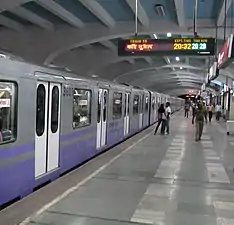
The system timings were changed due to the COVID-19 pandemic and as of September 2020, it operates between 08:00 and 20:00 IST.[82] Trains operate at an average speed of 55–60 km/h (34.18–37.28 mph) and stop for about 10 to 20 seconds at each station, depending on the crowd.[83] All stations have display boards showing the terminating station, current time, scheduled time of arrival and estimated time of arrival of trains in Bangla, Hindi and English. Digital countdown clocks are also present in the stations.[84][85] The coaches have line route-maps and speakers and displays, which provide details of upcoming stations in the three languages.[86][87][88] Navigation information is available on Google Maps.[89] Kolkata Metro has launched its own official mobile app Metro Railway, Kolkata for android smartphone users which provides information regarding station, train timing, fare and has online smart card recharge facility.[90]
Seat reservation
In 2008, the Kolkata Metro Railway experimented with the practice of reserving two entire compartments for women. This system was found to be ineffective and caused inconvenience for a lot of commuters (including women) and the plan was dropped.[91]
Now, certain sections of seats in each compartment are reserved for women, senior citizens and the physically challenged. The four-seat sections at each end of a coach are reserved for senior citizens and the physically challenged, and the two middle seat sections, between the general seat sections on each side, are reserved for women.[92][93][94]
Fare
The fare is based on the predetermined distance formulas. Kolkata Metro has the lowest starting fare in the country of ₹5 (7.0¢ US). For Line 1, the fare ranges from ₹5 (7.0¢ US) to ₹25 (35¢ US) and for Line 2, its ₹5 (7.0¢ US) to ₹30 (42¢ US).[95]
Tokens
After using the magnetic ticketing strip system from 1984 to 2011, Kolkata Metro introduced Radio-Frequency Identification (RFID) tokens by Centre for Railway Information Systems (CRIS) in partnership with Keltron in August 2011. The old magnetic strip reader gates were replaced with new RFID readers.[96][97]

Smart Card
After introducing RFID tokens, Kolkata metro introduced a Smart Card service provided by CRIS.[96] Earlier, four different types of smart cards were used: Minimum Multi Ride (MMR), Limited Multi Ride (LMR), General Multi Ride (GMR) and Extended Multi Ride (EMR). They were withdrawn on 7 November 2013 and a single type of Smart Card (General Smart Card) was introduced. Two new types of Tourist Smart Cards were also introduced (Tourist Smart Card – I and Tourist Smart Card – II). There is a compulsory refundable security deposit of ₹60 (84¢ US). The card is common for both Line 1 and 2.[98][99][100] Online smart card recharge facility was launched on 1 July 2020.[101][102]
Tourist Smart Card
Two new types of Tourist Smart Cards were also introduced (Tourist Smart Card – I and Tourist Smart Card – II). This type of smart card is for tourists and have unlimited rides. They cost ₹250 (US$3.50), valid for a day and ₹550 (US$7.70), valid for three days. A security deposit of ₹60 (84¢ US) is also charged.[99]
Durga Puja special services
The metro railway runs special night-long services during Durga Puja (Maha Saptami to Maha Navami) to help people travel faster and more conveniently for pandal-hopping. The services start at 13:00 and operate till 04:00 the next day. Pre-puja services are also run.[103][104][105]
Security

All stations are equipped with closed-circuit cameras, metal detectors and baggage scanners. The Railway Protection Force provides security in the premises.[106][107] Smoking is strictly prohibited in the metro premises. All stations in the East–West Corridor have half-height and full-height platform screen doors for elevated and underground stations, respectively.[22]
Other facilities
All stations have televisions which telecast news and songs.[108] WiFi was introduced at Park Street and Maidan metro station in 2016. Gradually, it was expanded to all the stations. The service is provided by Reliance Jio.[109][110]
Most stations have services such as ATMs, food outlets and chemist stalls. To ease crowding for recharging smart cards, two Automatic Card recharge machines were installed at Dum Dum.[111] On account of the Swacchota–i–Seba (in English, Cleanliness is service), a nationwide awareness and mobilization campaign on cleanliness, plastic bottle crushers were placed at multiple stations.[112]
Ridership
Kolkata Metro is the busiest metro system in India based on passengers carried per service. Each service carries an average of 2,465 people, while Delhi carries 1,111. Kolkata Metro carries around 7,00,00 people daily.[113] The daily and annual ridership has consistently risen since 1984. After the completion of the whole corridor from Dum Dum to Mahanayak Uttam Kumar in 1995, there was a huge leap in ridership. Low fares and fast and convenient travel have contributed to the high ridership figures. During the 2019 Durga Puja, there was a record ridership of 922,000.[114][45]
The Line 2 sees around 10,000 people daily.[115]
| Year | Ridership |
|---|---|
| 1985–86 | 7,600 |
| 1995–96 | 118,600 |
| 2001–02 | 166,000 |
| 2002–03 | 211,926 |
| 2003–04 | 248,090 |
| 2004–05 | 267,293 |
| 2005–06 | 295,542 |
| 2006–07 | 314,666 |
| 2009–10 | 375,268 |
| 2010–11 | 435,792 |
| 2013–14 | 520,000 |
| 2018–19 | 660,000 |
| 2020 | 633,000 |
Notes: ^ Data till February 2020.
Infrastructure
Rolling stock
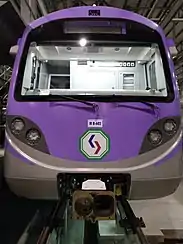
The rolling stock of Line 1 uses Indian gauge, a broad gauge track manufactured by Integral Coach Factory, Chennai (ICF), and the electrical components are manufactured by NGEF, Bangalore. Initially, the rolling stock fleet was composed of four-car rakes. Over the years there has been considerable expansion to the network, both underground and on elevated sections. With the increase in traffic, an eight-car rake formation has become standard.[121]
Depots and yards
There are four operational depots. The Noapara, Tollygunge and New Garia depots serve the North–South corridor, while the Central Park depot serves the East–West Corridor.[122][123][124] A depot at Joka for Line 3 and a yard at Airport for Line 4 are under construction.[125][76][126]
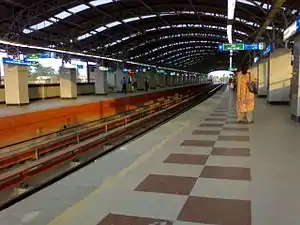
Stations and electrification
Kolkata Metro has 31 stations, of which 16 are underground, 13 are elevated and 2 are at grade. Currently, Noapara is the largest metro station in the system and it will be the interchange station for Line 1 and Line 4. The under-construction Howrah metro station is the deepest metro station in India.[35] The standard length of platforms in Kolkata Metro is 170 m. The metro stations of Gitanjali and Netaji have the shortest platforms of 163 m.[127] The average length between any two stations is 1.14 km (0.71 mi). The shortest distance is 0.597 km (0.371 mi) between Central and Chandni Chowk, and the longest distance is 2.15 km (1.34 mi) between Dum Dum and Belgachia. Since the Kolkata Metro has 750 V DC third rail electrification, electricity substations were built in Jatin Das Park, Central and Shyambazar. The tracks are ballastless with M1A track fittings.[91]
Signalling and telecommunication
Trains operate on typical Indian Railways automatic signalling technology. A Route Relay Interlocking System has been provided at New Garia depot and Tollygunge depot and Electronic Interlocking has been provided at Noapara depot to facilitate the prompt withdrawal and injection of rakes and to perform shunting operations inside the car shed for maintenance purposes. The Train Protection and Warning System (TPWS) is provided throughout the Metro Railway. It is designed to prevent collisions caused by human (operator) error.[128] A Train Describer System and Auto Train Charting are used to help the operation control centre monitor and plan train movement on a real-time basis. An Integrated Power Supply System and Microprocessor based Data Logger System have also been provided.[129] An integrated system of STM-1 and STM-4 optical fibre cable is used for all telecommunication, signalling, SCADA and other circuits in Line 1. The service is provided by RailTel.[130]
An upgrade of the existing signalling system of the North-South corridor from Indian Railways Signalling to Communication Based Train Control was planned by Metro Railway, Kolkata, at ₹467 crore (US$65 million) and the proposal was sent to Indian Railways, so that time interval between trains can be decreased to just 90 seconds from 5 minutes. In August 2019, Indian Railways gave a go-ahead to the proposal, and installation work is supposed to be complete within 2–3 years.[48]
Unlike the previous line, the East–West Corridor adopted the more advanced Communications Based Train Control system. It has cab signalling and a centralised automatic train control system consisting of automatic operation, protection and signalling modules. The signalling system is provided by Italy-based company Ansaldo STS. The other signalling equipment includes an integrated system with fibre optic cable, SCADA, radios, and a public-address system.[131][132][133][134]
Public address system
PA systems are present at all stations and their premises. A station master can make a necessary announcement to the passengers and staff, overriding the ongoing local announcement. Train PA systems are controlled by the motormen for announcements to passengers on the particular train.[135]
Issues
Since Kolkata Metro was constructed in the 1970s, there were some technical limitations. Due to the tunnel dimensions, and being under Indian Railways, Kolkata Metro opted for Indian metre gauge shell (2.7 m width) mounted upon 1,676 mm (5 ft 6 in) broad gauge bogies. The rakes have to be custom built and require a special assembly line involving additional costs thus limiting the options for rake manufacturers for Kolkata Metro Line 1.[136] From its inception, the coaches were manufactured by ICF, which lacked the pre-requisite knowledge for manufactured non-air-conditioning rakes. The 3000 and 4000 series rakes were faulty and delivered without any trials. In addition, Indian Railways signalling is used instead of European signalling. All of these factors have lead to snags, delays and accidents.[137][138][139]
Unlike Delhi Metro, Kolkata Metro is owned and operated by Indian Railways instead of an autonomous body, and it relies on Indian Railways for every decision.[25] The founder of Delhi Metro, E. Sreedharan, said Indian Railways are not experts at urban transport and misplanned the Kolkata Metro from the beginning, and he felt that a private company should run the metro and could bring it up to standard in five years.[140]
Network Map
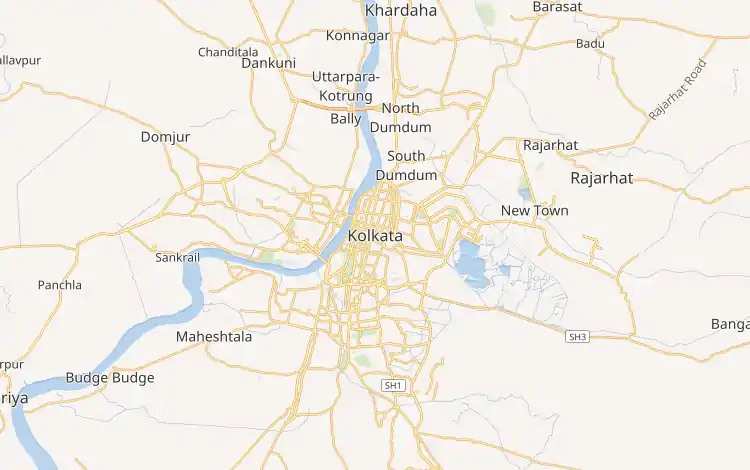
See also
References
- "Metro Railway Kolkata / Indian Railways Portal". mtp.indianrailways.gov.in. Archived from the original on 1 June 2019. Retrieved 30 May 2019.
- "Registered Office". www.kmrc.in. Archived from the original on 15 February 2020. Retrieved 29 July 2020.
- "ইস্ট-ওয়েস্ট মেট্রো: বিধাননগরের সঙ্গে জুড়ে গেল ফুলবাগান". www.anandabazar.com. 4 October 2020. Retrieved 8 October 2020.
- Jayanta Gupta (5 February 2020). "Kolkata's Tube Railway plan nipped in bud a century ago". The Times of India. Archived from the original on 8 February 2020. Retrieved 11 February 2020.
- Ganguly, Deepankar (23 August 2014). "Metro missed the train to Piccadilly". The Telegraph. Archived from the original on 22 August 2020. Retrieved 10 May 2020.
- Das, Madhuparna (5 March 2020). "100 years in the making, why Kolkata's east-west corridor is world's slowest metro project". ThePrint. Archived from the original on 30 March 2020. Retrieved 8 August 2020.
- "Kolkata Metro Rail Corporation Ltd". Kmrc.in. Archived from the original on 2 June 2017. Retrieved 27 January 2016.
- "Metro Railway - Kolkata, Route Map". 9 December 2004. Archived from the original on 9 December 2004. Retrieved 16 May 2020.
- "Brief History of Construction of Metro Railway Kolkata". mtp.indianrailways.gov.in. 15 January 2020. Archived from the original on 17 February 2019. Retrieved 20 May 2020.
- Mukherjee, Devjyot Ghoshal & Sharmistha (3 November 2009). "Delhi Metro speeds past Kolkata's". Business Standard India. Archived from the original on 30 December 2014. Retrieved 15 May 2020.
- "Kolkata Metro Line 1 provided start of the international career for Gus Klados". www.tunneltalk.com. Archived from the original on 9 June 2020. Retrieved 15 July 2020.
- "Metro Railway, Kolkata". kolmetro.com. 10 September 2007. Archived from the original on 10 September 2007. Retrieved 30 May 2020.
- Ghosal, Mainak. "Challenges faced(then & now)during Kolkata Metro Construction - A Study". Structural Engineering Digest. Archived from the original on 22 August 2020. Retrieved 15 July 2020.
- "Metro Railway, Kolkata, the confluence of culture, technology and eco-friendliness". mtp.indianrailways.gov.in. 13 March 2020. Archived from the original on 5 July 2019. Retrieved 20 May 2020.
- Hall, Andrew (2006). "Reinventing Calcutta". Asian Affairs. 37 (3): 353–360. doi:10.1080/03068370600906515. S2CID 218620885.
- Kolkata Old Map.jpg Archived 22 August 2020 at the Wayback Machine Lt. Col Mark Wood's Map of Kolkata in 1784-85 showing the extent of the Maratha Ditch
- Saha, Gouranga Prasad; Chaudhary, P.R. (1995). Calcutta Metro - Construction by 'Cut and Cover' and 'Shield Tunneling' Methods. Archived from the original on 22 August 2020. Retrieved 20 May 2020.
- "Kolkata Metro on a Reform Roadmap". mtp.indianrailways.gov.in. 4 December 2019. Archived from the original on 19 August 2013. Retrieved 18 July 2013.
- "Metro Railway, Kolkata". 9 December 2004. Archived from the original on 9 December 2004. Retrieved 10 May 2020.
- Chakraborty, Ajanta (25 December 2012). "From April, fly to Naoapara from Garia in 54 mins flat". The Times of India. Archived from the original on 22 August 2020. Retrieved 20 May 2020.
- "Hindustan Times – Archive News". Hindustan Times. Archived from the original on 10 October 2007.
- "Review of annual report and audited accounts of kolkata metro rail corporation limited (KMRCL) for the year 2016-17" (PDF). kmrc. Archived (PDF) from the original on 9 December 2019. Retrieved 17 May 2020.
- Chakraborty, Ajanta (13 August 2019). "India's deepest Metro station comes up 30m below Howrah railway station". The Times of India. Archived from the original on 2 September 2019. Retrieved 23 May 2020.
- Maiti, Subhendu (10 September 2019). "Questions over change of E-W Metro routes". The Statesman. Archived from the original on 22 August 2020. Retrieved 19 May 2020.
- B, Krishnendu (18 April 2019). "Systemic faults behind East-West Kolkata Metro delay, says expert". The Times of India. Archived from the original on 22 August 2020. Retrieved 19 May 2020.
- Das, Madhuparna (19 September 2019). "Delhi said no but Mamata got Kolkata Metro to change route — now houses are collapsing". ThePrint. Archived from the original on 11 December 2019. Retrieved 19 May 2020.
- Chakraborty, Ajanta (14 April 2018). "Kolkata metro: Kolkata: Metro tunnel boring hits steel wall at Esplanade". The Times of India. Archived from the original on 22 August 2020. Retrieved 3 June 2020.
- Jayanta Gupta (2 August 2018). "Kolkata metro: 'Microsurgery' at Esplanade to remove E-W Metro hurdle". The Times of India. Archived from the original on 7 July 2020. Retrieved 3 June 2020.
- Shukla, Darshana (6 August 2018). "Kolkata Metro | KMRCL plans microsurgery to solve E-W metro hurdle". Metro Rail News. Archived from the original on 3 June 2020. Retrieved 3 June 2020.
- Roy, Subhajoy (6 August 2019). "Underground wall to halt subsidence in Bowbazar". The Telegraph. Archived from the original on 9 September 2019. Retrieved 16 May 2020.
- "80 houses damaged, hundreds homeless as digging for Kolkata Metro tunnel hits water body". The New Indian Express. Archived from the original on 3 June 2020. Retrieved 3 June 2020.
- "Bowbazar mishap: KMRCL gives compensation to evacuated families". The Statesman. 8 September 2019. Archived from the original on 3 June 2020. Retrieved 3 June 2020.
- "Road Ahead….. Projects sanctioned". mtp.indianrailways.gov.in. 8 May 2014. Archived from the original on 17 February 2019. Retrieved 19 May 2020.
- editor (21 January 2017). "Kolkata Metro Commissioned 3rd Platform At Noapara on Friday". Kolkata24x7: Latest English and Bengali News, Bangla News, Breaking News, Business, Tollywood, Cricket. Archived from the original on 22 August 2020. Retrieved 20 May 2020.CS1 maint: extra text: authors list (link)
- Chakraborty, Ajanta (13 August 2019). "India's deepest Metro station comes up 30m below Howrah railway station". The Times of India. Archived from the original on 2 September 2019. Retrieved 20 May 2020.
- Sanjay Mandal (2 January 2020). "East West Metro design in last leg". The Telegraph. Archived from the original on 22 August 2020. Retrieved 29 July 2020.
- "Game of the name". The Telegraph. 26 July 2009. Archived from the original on 9 April 2019. Retrieved 20 May 2020.
- Jayanta Gupta (6 July 2017). "Metro prepares completion calendar for city projects". The Times of India. Archived from the original on 4 April 2019. Retrieved 29 July 2020.
- Chakraborty, Ajanta; Gupta, Jayanta (5 February 2020). "Kolkata Metro: 8am on Valentine's Day;Your date with East-West Metro". The Times of India. Archived from the original on 5 February 2020. Retrieved 5 February 2020.
- Ajanta Chakraborty (4 February 2020). "On track: First phase of East-West Metro to roll out on February 13". The Times of India. Archived from the original on 7 February 2020. Retrieved 30 May 2020.
- "Kolkata: Work on fast track as East-West Metro eyes new links in next two years | Kolkata News – Times of India". The Times of India. Archived from the original on 10 June 2019. Retrieved 10 June 2019.
- "New System Map of Kolkata Metro". mtp.indianrailways.gov.in. 5 December 2019. Archived from the original on 5 September 2019. Retrieved 17 May 2020.
- "Metro Railway Kolkata / Indian Railways Portal". 30 March 2018. Archived from the original on 30 March 2018. Retrieved 10 May 2020.
- "Milestone". mtp.indianrailways.gov.in. 4 December 2019. Archived from the original on 5 July 2019. Retrieved 20 May 2020.
- "Kolkata Metro services to start earlier on weekends from July 1". The Indian Express. 29 June 2019. Archived from the original on 27 September 2019. Retrieved 27 September 2019.
- "Kolkata Metro's extended route to Dakshineswar to start in January". Asianet News Network Pvt Ltd. Retrieved 18 November 2020.
- B, Krishnendu; Ajanta Chakraborty (10 June 2019). "Kolkata: Work on fast track as East-West Metro eyes new links in next two years". The Times of India. Archived from the original on 10 June 2019. Retrieved 19 June 2019.
- Mitra, Debraj (29 July 2020). "Quicker train hope in nod for Calcutta Metro signal upgrade". The Telegraph. Archived from the original on 3 November 2019. Retrieved 9 May 2020.
- "18 buildings damaged as Kolkata Metro tunnel-borer 'hits aquifer' – Times of India". 2 September 2019. Archived from the original on 5 September 2019. Retrieved 2 March 2020.
- IANS (4 June 2016). "East West Metro project cost to shoot up to nearly Rs 9,000 cr". Business Standard India. Archived from the original on 19 August 2016. Retrieved 17 May 2020.
- "East West Metro project cost to shoot up to nearly Rs 9,000 cr - Times of India". 5 January 2017. Archived from the original on 5 January 2017. Retrieved 17 May 2020.
- "Mixed bag for Bengal in Railway Budget 2016; Kolkata gets new Metro route". 25 February 2016. Archived from the original on 27 September 2016. Retrieved 25 September 2016.
- "East west metro will be started to run from 13 th february". Sangbad Pratidin. 3 February 2020. Archived from the original on 3 February 2020. Retrieved 3 February 2020.
- "First underwater metro to begin services in Kolkata from February 13". The Hindu. Special Correspondent. 4 February 2020. ISSN 0971-751X. Archived from the original on 26 February 2020. Retrieved 29 July 2020.CS1 maint: others (link)
- "Kolkata to get first underground metro station in 25 years". livemint. 4 October 2020. Retrieved 4 October 2020.
- "Piyush Goyal inaugurates Phoolbagan Station of Kolkata's East West Metro corridor". The Hindu. PTI. 4 October 2020. ISSN 0971-751X. Retrieved 4 October 2020.CS1 maint: others (link)
- "580 crore sanctions to build Joka-BBD Bagh Metro depot - Rail Analysis India". 18 June 2019. Archived from the original on 18 June 2019. Retrieved 17 May 2020.
- NANDI, SOUMITRA (30 January 2020). "Inability to procure land for depot leaves RVNL unsure of Joka-BBD Bag Metro's 1st phase commencement". www.millenniumpost.in. Archived from the original on 31 January 2020. Retrieved 17 May 2020.
- B, Krishnendu (1 March 2019). "Work begins at Joka Metro depot, wall built". The Times of India. Archived from the original on 22 August 2020. Retrieved 17 May 2020.
- Khare, Anushka (1 May 2020). "Bids invited for construction of Joka depot for Kolkata Metro Line 3". Urban Transport News. Archived from the original on 16 May 2020. Retrieved 17 May 2020.
- "RVNL Invites Bids for Kolkata Metro Line-3's Joka Depot". The Metro Rail Guy. 28 April 2020. Archived from the original on 22 August 2020. Retrieved 17 May 2020.
- Bandyopadhyay, Krishnendu (12 August 2020). "Kolkata: Joka-Esplanade to be India's first Metro to run on indigenous rails". The Times of India. Archived from the original on 12 August 2020. Retrieved 12 August 2020.
- "JSPL Becomes First Indian Company To Supply Head Hardened Rails To India's Metro Trains". Ommcom News. 12 August 2020. Archived from the original on 16 August 2020. Retrieved 12 August 2020.
- Chakraborty, Monotosh (10 July 2010). "Joka-Eplanade Metro on the anvil". The Times of India. Archived from the original on 2 October 2016.
- Jayanta Gupta (18 February 2017). "Defence ministry clears decks for Mominpore metro station". The Times of India. Archived from the original on 20 February 2017. Retrieved 17 May 2020.
- B, Krishnendu (17 April 2016). "Kolkata's Mominpore station jinx broken, Joka-BBD Bag Metro rises again". The Times of India. Archived from the original on 31 January 2017. Retrieved 18 May 2020.
- News, Urban Transport (19 July 2019). "RVNL invites bids for consultancy services for Kolkata Metro extension". Urban Transport News. Archived from the original on 22 July 2019. Retrieved 18 May 2020.
- "Dum Dum-Barrackpore Metro project awaits state nod". The Statesman. Archived from the original on 9 June 2012. Retrieved 7 July 2012.
- Mandal, Sanjay (7 December 2018). "Airport-Barasat metro line back to life". The Telegraph. Archived from the original on 2 November 2019. Retrieved 19 May 2020.
- "Track tweak for airport link". The Telegraph. 2 April 2012. Archived from the original on 30 August 2017. Retrieved 19 December 2016.
- Mandal, Sanjay (26 February 2015). "Going going... RIP Barrackpore Metro". www.telegraphindia.com. Archived from the original on 9 July 2017. Retrieved 29 July 2020.
- "Rail set to take over East-West". The Telegraph. 8 February 2011. Archived from the original on 22 August 2020. Retrieved 29 July 2020.
- Gupta, Jayanta (28 July 2018). "Airport Metro yard to be country's largest underground facility". The Times of India. Archived from the original on 2 August 2018. Retrieved 10 May 2020.
- Shah, Narendra (4 July 2020). "Railway Board approves Rs 527 crore for Kolkata Metro Line 6 corridor". Metro Rail News. Archived from the original on 8 July 2020. Retrieved 7 July 2020.
- Khare, Anushka (12 June 2020). "ITD bags balance civil work contract of Kolkata Metro's Airport Line". Urban Transport News. Archived from the original on 7 July 2020. Retrieved 7 July 2020.
- Sanjay Mandal (21 April 2019). "Metro hub 150m from Calcutta airport". The Telegraph. Archived from the original on 22 April 2019. Retrieved 16 May 2020.
- "Survey of 16 new Metro routes – Times of India". The Times of India. 2 January 2012. Archived from the original on 28 November 2018. Retrieved 27 November 2018.
- Rupak Banerjee (2 December 2016). "2017 start for Howrah EW Metro". The Times of India. Archived from the original on 28 November 2019. Retrieved 29 July 2020.
- "E-W Metro may run till Santragachhi". The Times of India. 28 August 2018. Archived from the original on 30 July 2019. Retrieved 29 July 2020.
- Sanjay Mandal (18 July 2019). "East-West load on struggling Metro". The Telegraph. Archived from the original on 23 July 2019. Retrieved 20 May 2020.
- "Kolkata Metro is now the 17th zone of Indian Railways". The Times of India. 29 December 2010. Archived from the original on 4 November 2012. Retrieved 29 December 2010.
- "Time Table". mtp.indianrailways.gov.in. 23 March 2020. Archived from the original on 4 July 2019. Retrieved 17 May 2020.
- Chakraborty, Ajanta; Gupta, Jayanta (5 February 2020). "Kolkata Metro: 8am on Valentine's Day;Your date with East-West Metro". The Times of India. Archived from the original on 5 February 2020. Retrieved 17 May 2020.
- Debraj Mitra (21 February 2018). "Metro gets real-time display boards". The Telegraph. Archived from the original on 22 August 2020. Retrieved 24 May 2020.
- Subhro Niyogi (16 February 2019). "Metro timetable to remain but boards to display dynamic ETA". The Times of India. Archived from the original on 22 August 2020. Retrieved 24 May 2020.
- Ramachandran, M. (3 November 2011), "East–West Metro in Kolkata", Metro Rail Projects In India, Oxford University Press, pp. 85–100, doi:10.1093/acprof:oso/9780198073987.003.0005, ISBN 978-0-19-807398-7
- "1st Refurbished Non-AC Train Rejoins Kolkata Metro". The Metro Rail Guy. 10 June 2016. Archived from the original on 14 July 2019. Retrieved 27 July 2020.
- "Kolkata 'underwater' Metro: City of Joy gets its second corridor after 36 years". The Indian Express. 14 February 2020. Archived from the original on 27 July 2020. Retrieved 27 July 2020.
- "Google Maps Transit Adds Indian Railways Schedules, Updated Bus and Metro Routes for 8 Cities". NDTV Gadgets 360. 12 May 2015. Archived from the original on 8 July 2020. Retrieved 7 July 2020.
- "Metro Railway Official Mobile Application (App)". mtp.indianrailways.gov.in. 14 August 2020. Archived from the original on 2 July 2019. Retrieved 15 August 2020.
- "Existing Features". www.mtp.indianrailways.gov.in. 15 January 2020. Archived from the original on 6 August 2013. Retrieved 30 June 2013.
- "Why we must still reserve seats for women on public transport". citizenmatters. 5 October 2017. Archived from the original on 21 June 2020. Retrieved 20 May 2020.
- "Big cheer for commuters! First phase of Kolkata Metro East-West Corridor opens; top 10 salient features". The Financial Express. 14 February 2020. Archived from the original on 15 February 2020. Retrieved 20 May 2020.
- "How to Ride the Kolkata Metro Rail or Subway: Insider Tips from a Local Girl! – Orange Wayfarer". www.orangewayfarer.com. 13 October 2018. Archived from the original on 22 August 2020. Retrieved 20 May 2020.
- "Metro Railway Kolkata / Indian Railways Portal". mtp.indianrailways.gov.in. Archived from the original on 8 July 2019. Retrieved 28 February 2020.
- Jayanta (31 July 2011). "Smart cards, tokens to replace Metro tickets today". The Times of India. Archived from the original on 22 August 2020. Retrieved 3 March 2020.
- Sanjay Mandal (10 May 2011). "A token ride on the Metro". The Telegraph. Archived from the original on 3 March 2020. Retrieved 3 March 2020.
- "East West Metro In Kolkata Begins Operations On Valentine's Day". www.outlookindia.com/outlooktraveller. 14 February 2020. Archived from the original on 22 August 2020. Retrieved 18 May 2020.
- "Business Rule of Metro Railway". mtp.indianrailways.gov.in. 13 March 2020. Archived from the original on 5 July 2019. Retrieved 18 May 2020.
- "For passenger convenience, Kolkata Metro introduces information in Bengali on smart cards". The Financial Express. 8 May 2018. Archived from the original on 9 July 2020. Retrieved 7 July 2020.
- "Kolkata Metro Web Based Card Recharge System". mtp.indianrailways.gov.in. 1 July 2020. Retrieved 1 July 2020.
- B, Krishnendu (30 June 2020). "Online recharge of Kolkata Metro Smart Card introduced". The Times of India. Archived from the original on 1 July 2020. Retrieved 1 July 2020.
- MP, Team (19 September 2019). "Kolkata Metro to run night-long special services to tackle Puja rush". www.millenniumpost.in. Archived from the original on 23 September 2019. Retrieved 19 May 2020.
- "Kolkata Metro To Run Night-Long Service During Durga Puja". NDTV.com. 3 October 2018. Archived from the original on 11 August 2019. Retrieved 19 May 2020.
- "Kolkata metro: Kolkata: Night-long Metro services during Durga Puja". The Times of India. 3 October 2018. Archived from the original on 9 October 2018. Retrieved 19 May 2020.
- "Kolkata metro to install x-ray baggage scanners". Daily News and Analysis. 5 October 2012. Archived from the original on 19 October 2012. Retrieved 7 November 2012.
- "Integrated Security System". mtp.indianrailways.gov.in. 14 January 2020. Archived from the original on 17 February 2019. Retrieved 19 May 2020.
- "INCODA TV HD inks sales partnership deal with Aidem Ventures - Exchange4media". Indian Advertising Media & Marketing News – exchange4media. Archived from the original on 22 August 2020. Retrieved 17 May 2020.
- KolkataJune 1, Indrajit Kundu; June 1, 2016UPDATED; Ist, 2016 23:30. "Get set for Wi-Fi service on Kolkata's underground metro rail!". India Today. Archived from the original on 22 August 2020. Retrieved 18 May 2020.CS1 maint: numeric names: authors list (link)
- "Free Wi-Fi at Metro stations". The Telegraph. 14 October 2015. Archived from the original on 22 August 2020. Retrieved 18 May 2020.
- "List of passenger amenities item at stations". mtp.indianrailways.gov.in. 2 January 2020. Archived from the original on 9 July 2019. Retrieved 24 May 2020.
- "Metro Railway observes "Swachhta – Hi –Seva"". mtp.indianrailways.gov.in. 11 September 2019. Retrieved 24 May 2020.
- Verma, Kanika (17 July 2019). "2,465 travel by every Metro train in Kolkata against 1,110 in Delhi -". Metro Rail News. Archived from the original on 6 December 2019. Retrieved 19 May 2020.
- "Metro Services". mtp.indianrailways.gov.in. Archived from the original on 12 August 2019. Retrieved 19 May 2020.
- Ajanta Chakraborty (15 February 2020). "On Valentine's Day, Kolkata falls in love with East-West Metro as trains start rolling out". The Times of India. Archived from the original on 18 February 2020. Retrieved 19 May 2020.
- "Comprehensive Mobility Plan Back to Basics Kolkata Metropolitan Area" (PDF). Archived (PDF) from the original on 7 May 2017. Retrieved 19 May 2020.
- "Performance of the Metro Railway, Kolkata for 2010-11" (PDF). indianrailways.gov.in. Archived (PDF) from the original on 2 April 2013. Retrieved 19 May 2020.
- "Performance of the Metro Railway, Kolkata for 2009-10" (PDF). indianrailways.gov.in. Archived (PDF) from the original on 23 August 2014. Retrieved 19 May 2020.
- Vibrant Railways Strengthening Bengal. Indian Railways. 2019. p. 22. Retrieved 19 May 2020.
- Singh, Shiv Sahay (20 March 2020). "Sharp fall in Kolkata Metro traffic". The Hindu. ISSN 0971-751X. Archived from the original on 21 March 2020. Retrieved 19 May 2020.
- "Rolling Stock" (PDF). mtp.indianrailways.gov.in. 2 May 2020. Retrieved 20 May 2020.
- Ajanta Chakraborty. "E-W Metro ready for trial run between Central Park & Sec V". The Times of India. Archived from the original on 27 July 2018. Retrieved 16 May 2020.
- Mitra, Debraj (4 March 2019). "Metro rake from China off vessel". The Telegraph. Archived from the original on 6 March 2019. Retrieved 16 May 2020.
- Jayanta Gupta. "Yard remodelling may affect Metro services for a month". The Times of India. Archived from the original on 29 May 2018. Retrieved 16 May 2020.
- Jayanta Gupta (7 October 2018). "Work gets going on Metro's airport station". The Times of India. Archived from the original on 3 April 2019. Retrieved 16 May 2020.
- "Rail Vikas Nigam invites bids for Joka-Esplanade Metro Project". Construction Week Online India. Archived from the original on 22 August 2020. Retrieved 16 May 2020.
- Mandal, Sanjay (26 May 2010). "Metro overshoots safety line - Platforms at two stations shorter than stipulated". The Telegraph. Archived from the original on 22 August 2020. Retrieved 30 June 2013.
- "Automatic warning to make Metro safer". The Times of India. 3 March 2013. Archived from the original on 16 January 2014. Retrieved 30 June 2013.
- "Existing Signalling System". mtp.indianrailways.gov.in. 1 January 2020. Archived from the original on 2 June 2013. Retrieved 30 June 2013.
- "Optical Fibre Cable Communication System". mtp.indianrailways.gov.in. 14 October 2014. Archived from the original on 17 February 2019. Retrieved 20 May 2020.
- "Kolkata Metro East-West Corridor". Railway Technology. Archived from the original on 21 May 2020. Retrieved 18 May 2020.
- Batra, Mannat (12 July 2019). "Kolkata East West Metro gets safety clearance for signalling systems". Urban Transport News. Archived from the original on 7 March 2020. Retrieved 18 May 2020.
- Mandal, Sanjay (29 July 2020). "Smart signalling for swifter East-West". The Telegraph. Archived from the original on 22 August 2020. Retrieved 18 May 2020.
- "Kolkata Metro Rail Corporation Ltd". www.kmrc.in. Archived from the original on 25 January 2020. Retrieved 24 May 2020.
- "Public Address System (PA System)". mtp.indianrailways.gov.in. 8 May 2014. Archived from the original on 17 February 2019. Retrieved 20 May 2020.
- Jayanta Gupta (23 August 2019). "Kolkata Metro will continue to have problems with rakes, thanks to its construction". The Times of India. Archived from the original on 27 January 2020. Retrieved 30 July 2020.
- "Kolkata Metro tragedy: 'Medha' rakes withdrawn from operation". Sirf News. 15 July 2019. Archived from the original on 22 August 2020. Retrieved 19 May 2020.
- Gupta, Jayanta (12 June 2019). "After Monday's disruption, Kolkata Metro back to old rakes; services dip". The Times of India. Archived from the original on 13 June 2019. Retrieved 19 May 2020.
- Mitra, Debraj (13 July 2019). "New trains with a history of snags". The Telegraph. Archived from the original on 22 August 2020. Retrieved 19 May 2020.
- Bhattacharya, Alokesh; J, Anand (9 January 2012). "DMRC MD E Sreedharan says many Indian cities need metro rail urgently". www.businesstoday.in. Archived from the original on 10 November 2017. Retrieved 19 May 2020.
External links
| Wikimedia Commons has media related to Kolkata Metro. |



